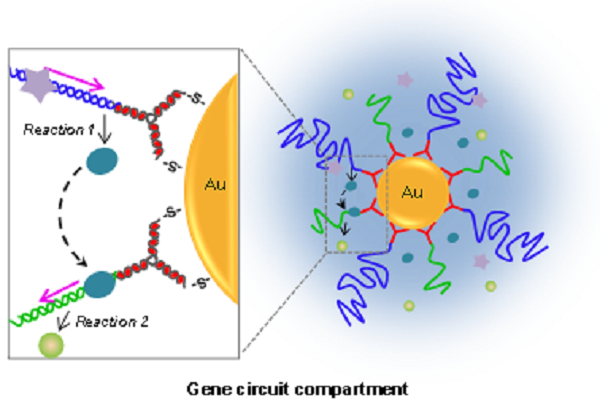Professor Yang Dayong Publishes A Paper in JACS
A research group led by Professor Yang Dayong from the School of Chemical Engineering and Technology, Tianjin University, fabricated a gene circuit compartment by coanchoring two function-related genes on the surface of gold nanoparticles and investigated the compartment effect on cascade gene expression in a cell-free system. The research results were published in the Journal of the American Chemical Society.
In living cells, genes that are functionally related to each other are usually compartmentalized and condensed in subcellular localizations to achieve efficient biosynthesis. For example, in eukaryotic cells, chromosomes are compartmentalized into discrete territories in the nucleus according to their functions; mitochondrial DNA, which synergistically encodes respiratory enzymes, is wrapped in the mitochondrion. Exploring the compartment effect on gene expression and regulation has important implications for understanding the interplay between the cellular organization of matter and biomolecular information processing.

The gene circuit consisted of a T7 RNA polymerase (T7 RNAP) expression cassette as a regulatory gene and a fluorescent protein expression cassette as a regulated reporter gene. Both the expression cassettes were attached to a Y-shaped DNA nanostructure whose other two branches were mercapto-modified in order to steadily anchor the gene expression cassettes on the surface of gold nanoparticles. Experimental results demonstrated that both the yield and initial expression rate of the fluorescent reporter protein in the gene circuit compartment system were enhanced compared with those in a free gene circuit system. Mechanism investigation revealed that the gene circuit compartment on nanoparticle made the regulatory gene and regulated reporter gene spatially proximal at the nanoscale, thus effectively improving the transfer efficiency of the regulatory proteins (T7 RNAP) from regulatory genes to the regulated reporter genes in the compartments, and consequently, the biochemical reaction efficiency was significantly increased. This work not only provided a simplified model for rational molecular programming of genes circuit compartments on nanointerface but also presented implications for the cellular structure–function relationship.
The research result was published in the Journal of the American Chemical Society, the relevant achievements had been applied for patents for inventions in China. Ph.D. student Guo Xiaocui and Assistant Professor Li Feng from School of Chemical Engineering and Technology, Tianjin University, are co-lead authors. The research was supported by the National Natural Science Foundation of China.

Figure 1. Schematic representation of design and preparation of gene circuit compartment. (a) Scheme of the gene circuit which included a T7 RNAP expression cassette and an eGFP expression cassette. (b) Molecular design of the 2S-eGFP gene and 2S-T7 RNAP gene and their synthesis based on PCR. (c) Gene circuit compartment enables expressed T7 RNAP to mainly locate in the compartment region and shuttle to eGFP expression cassettes more efficiently, thus enhancing cascade gene expression. Reaction 1: coupled transcription and translation for T7 RNAP. Reaction 2: coupled transcription and translation for eGFP.
Click the links to see the original article: https://pubs.acs.org/doi/10.1021/jacs.9b11407
The homepage of the research group: http://yanglab-dna.com/
By: Chen Binrui
Editor: Sun Xiaofang

